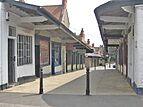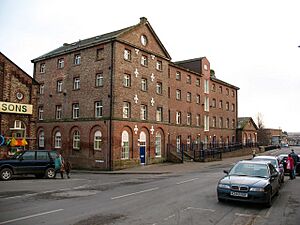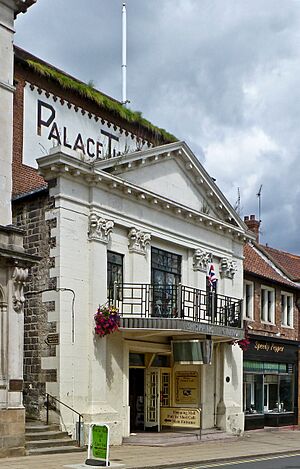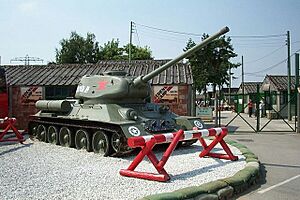Malton, North Yorkshire facts for kids
Quick facts for kids Malton |
|
|---|---|
|
|
|
| Population | 4,888 (2011 census) |
| OS grid reference | SE788722 |
| • London | 180 mi (290 km) S |
| Unitary authority |
|
| Ceremonial county | |
| Region | |
| Country | England |
| Sovereign state | United Kingdom |
| Post town | MALTON |
| Postcode district | YO17 |
| Dialling code | 01653 |
| Police | North Yorkshire |
| Fire | North Yorkshire |
| Ambulance | Yorkshire |
| EU Parliament | Yorkshire and the Humber |
| UK Parliament |
|
Malton is a lively market town in North Yorkshire, England. It is also a civil parish and an electoral ward. In 2011, about 4,888 people lived here.
Malton is located north of the River Derwent. This river used to be the old border between different parts of Yorkshire.
Across the river from Malton is a town called Norton. You can find the Malton bus station and Malton railway station in Norton.
Malton is a busy place for shopping and business in the area. Its town centre has many small, traditional shops and well-known high street stores.
People often call Malton "the food capital of Yorkshire". The Sunday Times even named it one of the best places to live in Britain in 2017 and 2018. Malton was also chosen as the most dog-friendly town in the UK in 2018/19 and 2020.
Contents
History of Malton
Ancient Times: British and Roman History
Long ago, in 1869, an old British oak canoe, seven feet long, was found near Malton. This shows that people lived here a very long time ago.
The first known building in Malton was a Roman fort. It was built around 71 AD, when the Romans were in Britain. This fort was on the north side of the River Derwent. A large town grew up around it, on the south side of the river in Norton.
A Roman cavalry unit, called the Ala Gallorum Picentiana, was stationed here. The Romans stayed for about 400 years, leaving in 429 AD when their empire ended. During their time, people in Malton even made jet jewellery.
Medieval Malton: Castles and Markets
By 1138, there was a settlement in New Malton. Old Malton probably started around the same time. A monastery was built in Old Malton between 1147 and 1154.
The first mention of a market in New Malton was in 1283. This means people like butchers and craftsmen were selling their goods there.
In the 11th century, a wooden Norman castle, Malton Castle, was built. Later, it was rebuilt in stone. Important people like Richard the Lionheart (in 1189) and Edward II (in 1307) visited the castle. Over time, the castle became a ruin.
In 1569, a new house was built on the castle site. It was rebuilt even grander in 1602. This house was very impressive, but it was later taken down in 1674. Today, only a small part of it remains, called The Old Lodge Hotel.
Malton in the 18th, 19th, and Early 20th Centuries
In the 1700s, Malton worked to improve its market for traders, especially for butchers.
Malton Town Hall was first used as a butter market. Butter was a very important product for farmers back then. The town hall was changed and made bigger many times over the years.
The town's Shambles, which is a street with butcher shops, used to be near St Michael's Church. The Talbot Hotel, a historic building, dates back to the early 1600s. It was first a hunting lodge and became an inn in 1740. It was also a stop for coaches.
In 1801, the population of Old and New Malton was 3,788 people. In 1809, the Talbot Hotel was made bigger and more modern.
The town's Assembly Rooms opened in 1814, where people could gather. By 1833, Malton was trading a lot of coal, corn, and butter. It had two churches and several schools.
In 1832, Malton's streets were lit with gas for the first time. Electric lights came later, in 1893. By 1867, the Malton Waterworks was providing water to homes.
Medical care started with The Dispensary in 1835. The Malton Cottage Hospital opened in 1905. In 1856, the town had its own police force. By 1881, the Malton Fire Brigade was also working.
By 1881, the population of Old and New Malton grew to 8,750 people. New industries like iron and brass factories started.
The railway came to Malton in the mid-1800s. The line from York to Scarborough opened in 1845. The Malton railway station is now a protected historic building.
In the early 1900s, electricity was installed in most of the town. Before World War II, new buildings like the Court House and Police Station were built. The town was bombed during the war.
The River Derwent was made easier to travel on around 1725. This allowed barges to carry goods and farm products.
The river continued to be used for transport even after the railway arrived. However, its use declined when the railway bought the river and made it harder for boats to travel.
Local Government in Malton
In the past, Malton was a parliamentary borough and had its own Members of Parliament. One famous MP was Edmund Burke.
Today, North Yorkshire Council is the local authority for Malton. The current Member of Parliament for the area is Kevin Hollinrake.
Malton Today
The Fitzwilliam family has been very important in Malton's history for centuries. Their estate still owns many businesses in the town. A book was written in 2013 about their long connection to Malton.
Today, you can visit the remains of the Roman fort at 'Orchard Fields'. There's also Malton Priory, an old monastery. Eden Camp, a museum about military history, is just outside town. Malton Museum is located in Yorkersgate.
Malton has its own independent cinema, The Palace Cinema, and a theatre called The Milton Rooms. You'll find many independent shops, cafes, and restaurants.
Malton has two local breweries. Brass Castle Brewery hosts an annual 'BEERTOWN' festival. Malton Brewery is one of Britain's smallest breweries.
The famous writer Charles Dickens visited Malton often. Some buildings in the town even inspired his stories. Malton also appears in the book All is Bright – A Yorkshire Lad's Christmas.
Malton and Norton are seen as the main towns in the Ryedale District. The local council plans for new homes, jobs, and shops to be built here until 2027.
Malton has a market every Saturday and a farmers' market once a month. The town also has a war memorial and several historic churches. The livestock market will soon move to a new location near Eden Camp.
Malton is a great base for exploring nearby places like York, Pickering (where you can find the North Yorkshire Moors Railway), and the seaside towns of Scarborough, Filey, and Whitby. A long-distance walking path, The White Rose Way, also goes through Malton.
Malton and Norton are well-known for horse racing. Many training stables are nearby. Horse racing has been a big part of the area's history for hundreds of years.
Malton sometimes experiences flooding, with notable floods happening in recent years.
We Love Malton Campaign
The 'We Love Malton' campaign started in 2009. Its goal was to make Malton a popular place for "Food Lovers" and attract more visitors. The town is now known as the food capital of Yorkshire.
Malton Community Interest Company (Malton CIC)
Malton CIC was formed in 2011. This group helps the local area by giving money to organizations like the Ryedale Book Festival. They also help fund free parking in the Market Place and organize the Malton Food Lovers Festival.
Religion in Malton
Malton has several churches, including St Michael's Anglican church and Ss Leonard & Mary Catholic church. The Methodist Wesley Centre is also being updated to be a community hub.
Education in Malton
Malton and Norton have two secondary schools: Malton School, which was founded in 1547, and Norton College. For younger students, there are St Mary's RC Primary School, Norton Community Primary School, and Malton Community Primary School.
Media and News
Local news and TV shows for Malton come from BBC Yorkshire and ITV Yorkshire. You can also get signals from BBC North East and Cumbria and ITV Tyne Tees.
Malton's local radio stations include BBC Radio York, Greatest Hits Radio Yorkshire, Capital Yorkshire, and Coast & County Radio. Local newspapers that cover the town are The York Press and Gazette & Herald.
Climate in Malton
Malton has a maritime climate, which means it has cool summers and mild winters. The nearest weather station is High Mowthorpe, about 6 miles (10 km) east of the town. Malton itself is usually a bit warmer because it's at a lower elevation.
| Climate data for High Mowthorpe 175m asl, 1991–2020, Extremes 1960– | |||||||||||||
|---|---|---|---|---|---|---|---|---|---|---|---|---|---|
| Month | Jan | Feb | Mar | Apr | May | Jun | Jul | Aug | Sep | Oct | Nov | Dec | Year |
| Record high °C (°F) | 13.3 (55.9) |
15.0 (59.0) |
20.6 (69.1) |
21.7 (71.1) |
25.0 (77.0) |
28.4 (83.1) |
28.5 (83.3) |
33.2 (91.8) |
26.4 (79.5) |
21.7 (71.1) |
16.2 (61.2) |
14.5 (58.1) |
33.2 (91.8) |
| Mean daily maximum °C (°F) | 5.8 (42.4) |
6.4 (43.5) |
8.7 (47.7) |
11.4 (52.5) |
14.5 (58.1) |
17.3 (63.1) |
19.9 (67.8) |
20.0 (68.0) |
16.8 (62.2) |
12.7 (54.9) |
8.7 (47.7) |
6.2 (43.2) |
12.4 (54.3) |
| Daily mean °C (°F) | 3.4 (38.1) |
3.7 (38.7) |
5.4 (41.7) |
7.6 (45.7) |
10.4 (50.7) |
13.1 (55.6) |
15.5 (59.9) |
15.6 (60.1) |
13.2 (55.8) |
9.8 (49.6) |
6.2 (43.2) |
3.7 (38.7) |
9.0 (48.2) |
| Mean daily minimum °C (°F) | 1.0 (33.8) |
1.0 (33.8) |
2.1 (35.8) |
3.8 (38.8) |
6.3 (43.3) |
8.9 (48.0) |
11.0 (51.8) |
11.3 (52.3) |
9.6 (49.3) |
6.9 (44.4) |
3.7 (38.7) |
1.3 (34.3) |
5.6 (42.0) |
| Record low °C (°F) | −10.2 (13.6) |
−10.9 (12.4) |
−8.9 (16.0) |
−5.7 (21.7) |
−2.3 (27.9) |
−0.6 (30.9) |
3.9 (39.0) |
3.9 (39.0) |
0.6 (33.1) |
−2.8 (27.0) |
−7.5 (18.5) |
−14.6 (5.7) |
−14.6 (5.7) |
| Average precipitation mm (inches) | 64.8 (2.55) |
55.5 (2.19) |
48.9 (1.93) |
55.4 (2.18) |
51.4 (2.02) |
75.0 (2.95) |
63.7 (2.51) |
71.9 (2.83) |
62.3 (2.45) |
72.5 (2.85) |
79.3 (3.12) |
70.6 (2.78) |
771.2 (30.36) |
| Average precipitation days (≥ 1.0 mm) | 12.6 | 11.7 | 9.8 | 9.5 | 9.4 | 10.6 | 10.6 | 11.1 | 9.7 | 12.2 | 13.7 | 12.6 | 133.6 |
| Mean monthly sunshine hours | 54.8 | 81.2 | 120.9 | 161.1 | 208.5 | 188.4 | 198.0 | 181.2 | 141.6 | 104.3 | 65.9 | 51.1 | 1,557 |
| Source 1: Met Office | |||||||||||||
| Source 2: Royal Netherlands Meteorological Institute | |||||||||||||
Getting Around Malton: Transport Links
Malton railway station is on the line between York and Scarborough. Trains run every hour to places like Scarborough, York, Leeds, and Manchester. You can even get to London in about two and a half hours with a change at York.
There are plans to reopen the old railway line between Malton and Pickering. This would allow trains to go all the way to Whitby.
The A64 road goes around Malton, connecting it to Leeds, York, and Scarborough. The A169 road connects to Pickering and Whitby.
Malton's main bus services are run by Yorkshire Coastliner. They connect the town to Leeds, York, Whitby, and Scarborough. There are also local services to Pickering and other nearby villages.
Famous People from Malton
Many interesting people have come from Malton, including:
- Simon Dyson – a professional golfer
- Terry Dyson – a professional football player
- Tim Easterby – a racehorse trainer
- Scott Garnham – an actor
- James Martin – a well-known TV chef
- Leo Sheffield – a singer and actor
- Jon Sleightholme – a former England Rugby Union player
- Ryan Swain – a TV and radio presenter
- Lucy Hall – an Olympic trap shooter
|
See also
 In Spanish: Malton para niños
In Spanish: Malton para niños

















